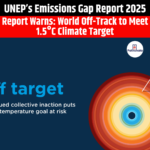IMF Projects India’s FY26 Growth at 6.6%
|
General Studies Paper II: Important International Institutions, Fiscal Policy |
Why in News?
Recently, the International Monetary Fund (IMF) revised India’s FY26 economic growth projection upward to 6.6% in the latest World Economic Outlook (WEO). This reflects stronger-than-expected performance in the first quarter.
Overview of IMF’s FY26 Growth Projection for India
- In its October 2025 World Economic Outlook (WEO), the International Monetary Fund (IMF) has increased India’s Gross Domestic Product (GDP) growth forecast for the fiscal year 2025-26 (FY26) to 6.6%, up from the previous estimate of 6.4%. This adjustment reflects a 20 basis point upward revision.
- The revised forecast of 6.6% for FY26 represents a 0.2 percentage point increase from the IMF’s earlier projection of 6.4%.
- The IMF attributes this positive revision primarily to a strong first-quarter performance, where India’s economy expanded by 7.8% during the April-June 2025 period.
- The IMF’s October 2025 projection of 6.6% for FY26 is consistent with the World Bank’s revised forecast of 6.5%, indicating a consensus among major international financial institutions regarding India’s economic outlook.
- Looking ahead, the IMF projects a moderation in India’s growth to 6.2% in FY27. This anticipated because global trade uncertainties and potential external shocks.
Factors Driving the Upward Revision in India’s FY26 Economic Growth
- Impact of GST Reforms: The Indian government’s implementation of sweeping Goods and Services Tax (GST) reforms, including reductions in tax rates on a wide range of consumer goods and services, has significantly bolstered domestic demand. These reforms have made goods more affordable, thereby stimulating consumption and contributing to economic growth.
- Resilience Amid Global Trade Tensions: Despite the challenges posed by the reintroduction of U.S. tariffs on Indian imports in July 2025, India’s economy has shown remarkable resilience. The strong domestic consumption and robust economic fundamentals have mitigated the adverse effects of these external trade barriers. This resilience underscores India’s capacity to maintain growth momentum.
- Favorable Inflation Trends: India’s inflation rate has remained relatively low, with the Consumer Price Index (CPI) recorded at 2.8% in 2025. This stable inflation environment has helped maintain consumer purchasing power and supported sustained demand across various sectors. The easing of inflationary pressures has reinforced India’s position as the world’s fastest-growing major economy.
- Robust First-Quarter Performance: India’s economy demonstrated exceptional growth in the first quarter of fiscal year 2025-26, expanding by 7.8%. This robust growth was driven by private consumption, which has remained a cornerstone of India’s economic expansion.
- Sectoral Contributions: Services Sector continues to be the largest contributor to GDP, driven by information technology, financial services, and telecommunications. Industry sectors such as manufacturing and construction activities have shown resilience and the Agriculture sector has benefited from favorable monsoon conditions and government support, contributing to rural demand.
Implications for India’s Global Economic Standing
- India’s revised FY26 GDP growth forecast positions it as the fastest-growing major economy globally. This upward revision underscores India’s robust economic performance amidst global uncertainties. This growth trajectory enhances India’s stature in the global economic arena, signaling its resilience and potential as a key economic player.
- The IMF’s revised growth forecast bolsters investor confidence in India. The country’s economic stability and growth prospects make it an appealing destination for both domestic and foreign investments. This influx of investments is expected to further stimulate economic activities, create employment opportunities.
- India’s economic growth enhances its bargaining power in international trade negotiations. The country’s expanding market and economic influence enable it to advocate for favorable trade agreements and policies. This allows India to play a more significant role in shaping global trade dynamics.
- India’s robust economic performance contributes to global economic stability. As one of the world’s largest economies, India’s growth helps offset slowdowns in other regions, such as advanced economies facing challenges.
Key Challenges Constraining India’s Economic Growth
- Inflationary Pressures: Despite a recent decline in wholesale price inflation to 0.13% in September 2025, down from 0.52% in August, inflation remains a concern. The Reserve Bank of India (RBI) projects consumer price inflation at 2.8% for the fiscal year 2025–26. This is relatively low, sustained inflation can erode purchasing power and affect consumer sentiment, potentially impacting economic growth.
- Fiscal Deficit: India’s fiscal deficit for the first five months of the fiscal year 2025–26 stood at ₹5.98 lakh crore, approximately 38.1% of the annual target. The government aims to reduce the fiscal deficit to 4.4% of GDP for the full year, down from 4.8% in the previous fiscal year. Achieving this target requires stringent fiscal discipline and effective revenue mobilization.
- External Debt: As of June 2025, India’s external debt reached $747.2 billion, an increase of $11.2 billion from March 2025. While the external debt to GDP ratio moderated to 18.9% from 19.1%, the rising debt levels pose risks related to currency fluctuations and repayment pressures.
- Employment Challenges: Although India’s unemployment rate declined to 5.1% in August 2025, down from 5.2% in July, the labor market remains under pressure. The economy needs to generate sufficient employment opportunities to absorb the growing working-age population and reduce underemployment, particularly in rural areas.
- Global Trade Uncertainties: The reintroduction of U.S. tariffs on Indian imports in July 2025 has heightened trade tensions. India’s export sector faces challenges from global economic slowdowns and protectionist policies, which could impact future growth prospects.
|
World Economic Outlook (WEO)
|










